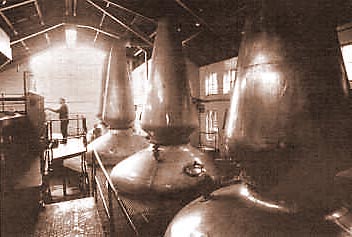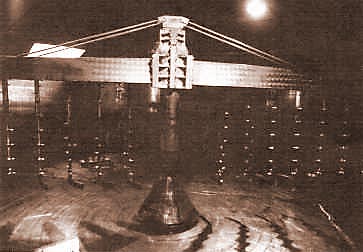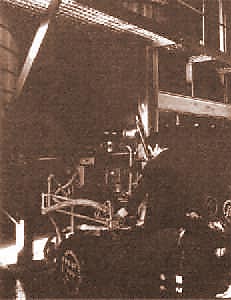 When literary people think of the Isle
of Jura, they are usually thinking about George Orwell and
'l984'. Orwell completed this futuristic novel in 1948, while
living on the island in the farmhouse of Barnhill. But with the
passage of time, two things have altered.
When literary people think of the Isle
of Jura, they are usually thinking about George Orwell and
'l984'. Orwell completed this futuristic novel in 1948, while
living on the island in the farmhouse of Barnhill. But with the
passage of time, two things have altered.
One is that the year of the novel is now in the past, and the awesome imagination of Eric Blair (aka G Orwell) doesn't seem excessive any more. The ominous presence of 'Big Brother' and the cynical manipulation of thought are hardly strange to us these days.
The other change is that the Isle of Jura Distillery is back in business. It's thought to have been established in 1810 and rebuilt 60 years later, but closed down during the First World War. After further rebuilding, it began to produce malt whisky once again in 1963. Thus it was no more than a sorry unproductive hulk, in a magnificent inner Hebridean setting, while Eric thundered at his typewriter a few miles along the coast.
Here's the big question: would his predictions for '1984' have been a little less pessimistic if there was a chance of a dram down the road? Literary purists might see this as a trivial issue: but whisky purists might not.
A fascinating characteristic of the Jura dram is that it is produced a short swim away from the island of Islay, yet it differs so remarkably from those seven neighbours. Experienced tasters will detect some saltiness in it, yet none of the seaweed pungency to be found - in varying degrees - in the Islay malts.
Distillery manager Willie Tait emphasises that, at the maturing stage, there is no attempt to induce flavour into the Jura malt. Less than a tenth of the bottled product will have been held in sherry casks, and the rest in second-fill Scotch whisky casks - from which, therefore, the vanilla influence of the original bourbon filling will have been largely removed. 'We find,' he says, 'that this reflects the character of our whisky without unnecessary enhancement.'
 Whence does this island whisky from the
Invergordon stable derive its glorious gentleness? Soft water
from a spring called Bhaille Mharghaidh is used in the mash. It
has flowed over rock and does not carry too many traces of peat.
Whence does this island whisky from the
Invergordon stable derive its glorious gentleness? Soft water
from a spring called Bhaille Mharghaidh is used in the mash. It
has flowed over rock and does not carry too many traces of peat.
The malted barley (some of which actually comes from Islay, curiously enough) is only slightly peated: the strength is calibrated at two parts per million of phenols, compared with 50-plus in the case of such lusty next-door malts as the Ardbeg and the Lagavulin.
Then we have the Jura stills. The two pairs of low wines and spirit stills are among the tallest in the industry: their height, of course, is a factor contributing to a light and pure spirit. Unusually, there's little visible difference in size between the wash and spirit stills, which are heated internally by copper coils pulsing with steam.
Willie Tait, who has the unflagging enthusiasm for his job characteristic of distillery managers (and the patience to describe its minutiae) explains that when the charger holds 48,000 litres of wash, this is divided between the first pair of stills. The liquid will reach the lip of the 'man-door', the access hatch which opens for inspection and cleaning.
With the steam on and the wash boiling, the liquid rises quickly into the neck of the still. 'When you get to that stage you must take the steam off. That's called braking the still.' I love that expression, with its steam loco connotation.
 Then the heat is allowed to rise slowly
until the still is running at a simmer, staying at that pace for
around eight hours until a hydrometer reading shows there is no
more alcohol in the distillate.
Then the heat is allowed to rise slowly
until the still is running at a simmer, staying at that pace for
around eight hours until a hydrometer reading shows there is no
more alcohol in the distillate.
The second distillation in the smaller spirit stills is taken even more gently. These stills will run for 11 hours, but will be producing the precious 'middle cut' for only a third of that time. There are two steam coils in each still: and while the middle cut is running, one of these coils is shut down so that the young Jura comes into the world very slowly and gently.
At birth it will be about 70 per cent alcohol by volume, and this is reduced to 63.5 per cent by adding water from its mother spring. And from that point onwards the whisky will be contained only in oak vessels until filling into barrels.
There is much more to be learned at the Jura Distillery, but I have concentrated on the distilling process because of its primary influence on this distinctive island malt. There are the earthen-floored original maturing warehouse with its craftsmanlike roof joists, dating from 1810, now used as a repairing cooperage; the CIP (cleaning in place) system for the mash tuns and washbacks which was unique when installed; the balance of cultured and brewer's yeast to give a quick start and long-running fermentation.
And then, of course, there are the matchless views from Jura. George Orwell would have been familiar with those: but I'm sure he would regret missing the rest.

Unless otherwise noted, all information in this site © The Scotch Malt Whisky Society, Edinburgh, Scotland, 1997.